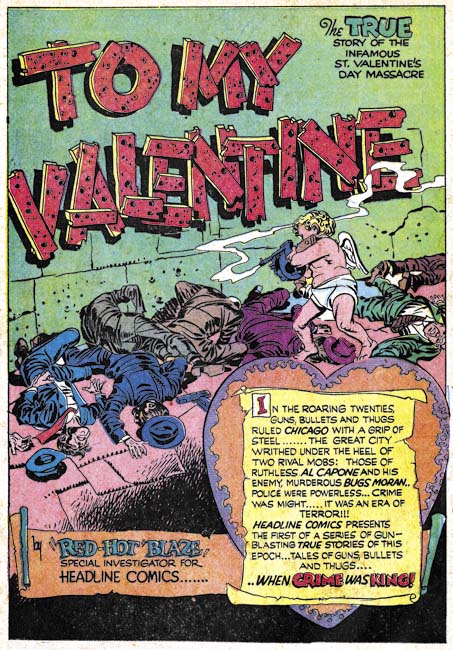
Headline #23 (March 1947) “To My Valentine”, pencils and inks by Jack Kirby
After the failure of Stuntman and Boy Explorers for Harvey Comics, Joe Simon and Jack Kirby began looking for a publisher that they could produce comics for. They eventually made a deal with Prize Comics where they converted the existing Headline Comics from a superhero to a crime title. The first crime issue was Headline #23 (March 1947) and it is packed with great stuff. Full of material all drawn by the dynamic Jack Kirby. The premise, at least initially, was that Headline would consist of true stories often presented by “Red Hot” Blaze. One of which was “To My Valentine” the story of the St. Valentine’s Day Massacre.
The story as presented by Simon and Kirby starts with a dramatic full page splash. Cupid with a machine gun having just finished mowing down a line of men. It seems at least one of them had a handgun so it can be presumed that they were criminals. Text presented as a scroll informs us about the war between two gangs one headed by Al Capone and the other Bugs Moran.
The first story page depicts a man discarding a Valentine Day card and then abusing the store’s proprietor when he asked to be paid for the damaged card. An odd start for a crime story, but then again Simon and Kirby were always very original in their story telling. This beginning indicates the story is taken place on Valentine’s Day and introduces the reader to the thug-like nature of the man.
On the next page the readers follows the man to his arrival to a group of gangsters as they prepare for some undisclosed criminal activity. Only they become interrupted by the appearance of some uniformed policeman. Or rather as is revealed in the last panel, as members of the “other mob” dressed up as cops.
Page four has the arrival of boss and massacre of the apprehended gangsters. Pretty dramatic stuff. But interestingly nowhere is either gang mentioned by name. The reader will learn later that the victims belonged to Bugs Moran gang but the name of the leader of this particular confrontation is never revealed. While some of the facts about the St. Valentine’s Day Massacre are well known the perpetrators have never been positively identified.
Page five introduces “Red Hot” Blaze as he bridges the story from the massacre to the arrival of a reported to interview a prison inmate. Only the reporter finds out that the inmate is out, not on bail but for a stroll. The reporter does not wait for the inmate’s return as he already has a great story for his newspaper. The reporter returns later to interview the prisoner only to be roughed up by the inmate right in front of the sheriff. When the reporter objects to the treatment he has received the sheriff responds he did not see anything. “Red Hot” Blaze describes the story as an example of the corruption in Chicago at that time. Still this sub-story seems only remotely related to the rest of the Valentine’s Day Massacre story. It takes up two pages, as much room as the massacre itself. Why did Simon and Kirby include it?
Page five ends with Bugs Moran hearing about a party the other gang was having and on the final page of the story we find Bug’s gang performing their own massacre at their rival’s party. This was supposed to have taken place at the Manning’s Hotel but a Google search fails to come up with any mention of Bug’s revenge.
“Red Hot” Blaze returns once again in the last two panels and in the final one says:
Just another thought cousins! … it isn’t hard to give crime another boost to a new heydey … Those who play ball with the black market boys and their like are only giving a new ‘go-signal to mob rule! Don/t encourage them … you’ll pay a higher price later!!!
Here Simon and Kirby reveal the story’s real theme and the explanation for the sub-story of the newspaper reporter from Chicago. “To My Valentine” is not just, or even primarily, about the gang war between Al Capone and Bugs Moran. Rather the story is concerned about the corruptive influence of organized crime and the dangers involved in supporting it. The years immediately following War World II were prosperous especially when compared to the pre-war depression period. But although many were now earning good incomes the country’s industry as a whole took some time to re-tool from the production of military goods. People had money but could not always spend it on the goods they wanted. Under such conditions a black market sprung up (or rather continued from the war years). Here Simon and Kirby are warning about the possible outcome of supporting the black market and allowing it to prosper.

